On View
The U.K.’s First Major Robert Indiana Survey Pulls Out All the Stops to Make the Case for Him as a Multifaceted Pop Master
"Robert Indiana: Sculpture 1958-2018" is on view through January 8, 2023 at Yorkshire Sculpture Park.
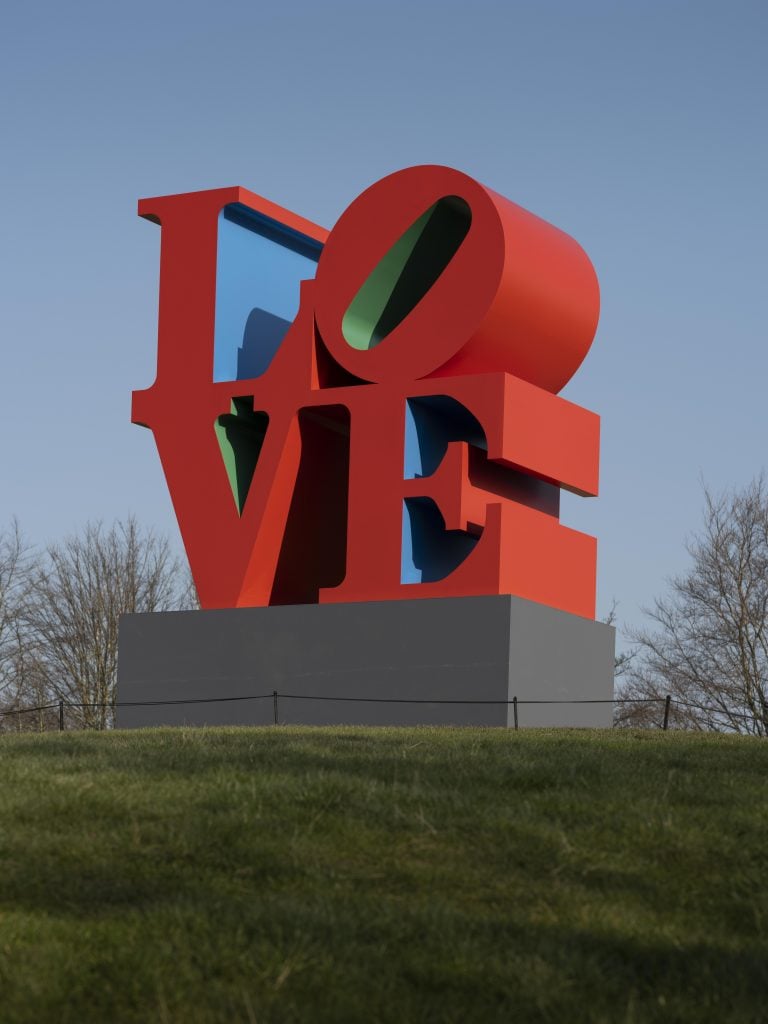
"Robert Indiana: Sculpture 1958-2018" is on view through January 8, 2023 at Yorkshire Sculpture Park.

Naomi Rea

Pulling up to Yorkshire Sculpture Park earlier this week, visitors were welcomed by a large-scale version of Robert Indiana’s iconic LOVE sculpture in vivid red, blue, and green, framed by a cloudless sky. Heralding the first major exhibition at the park since the pandemic’s onset, the artwork offers a much-needed message of hope.
Amid the geopolitical crisis unfolding in Ukraine, the work has taken on a new poignancy. The curator of the show, YSP director Clare Lilley, recalled driving in after a day of devastating news and finding herself tearing up in front of LOVE. “I hope that this exhibition is one that lifts people and frankly reminds us all of the importance of love, the importance of community, and the importance of being together,” she said.
More than 56 works by the American artist are on view in the major exhibition, which is surprisingly the first significant exhibition of Indiana in the U.K. Spanning 60 years of the artist’s career, it includes sculpture, paintings, and prints made between 1958 and Indiana’s death in 2018, displayed outdoors in the sprawling acreage of the park as well as in its Underground gallery.
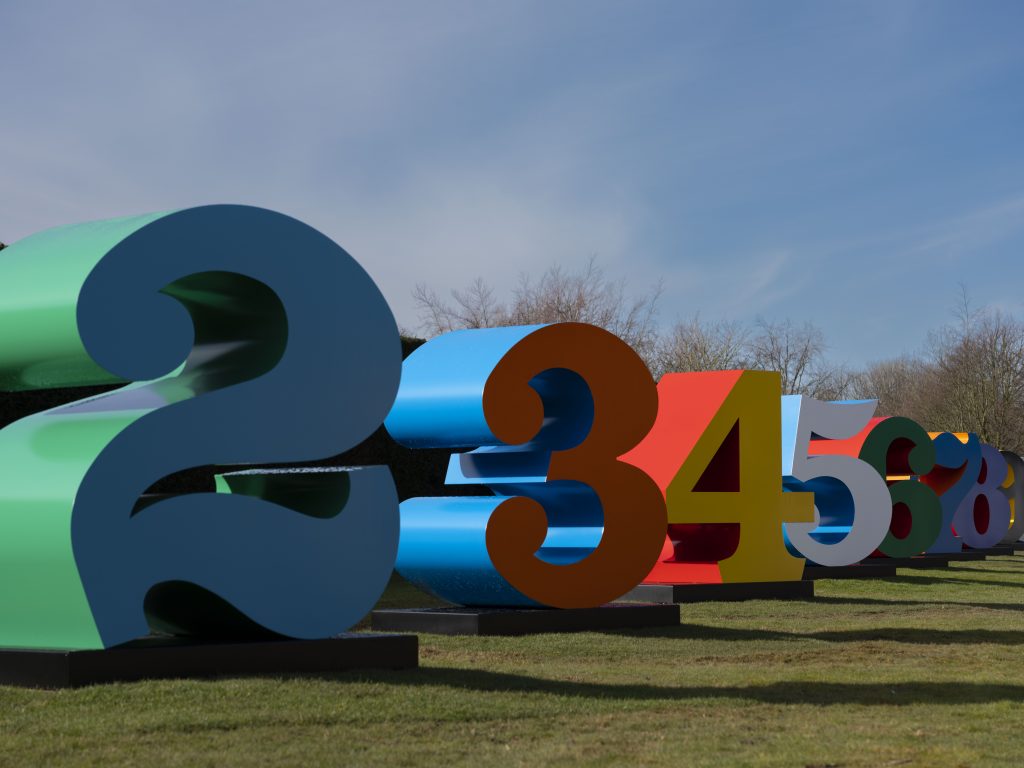
Robert Indiana, ONE Through ZERO (The Ten Numbers) (1980-2001). Installation view at Yorkshire Sculpture Park, 2022. Photo: © Jonty Wilde, courtesy of Yorkshire Sculpture Park. Artwork: © 2022 Morgan Art Foundation Ltd./ Artists Rights Society (ARS), New York/DACS, London
Six major sculptures are shown outdoors, including a set of ten vibrant polychrome painted aluminum sculptures titled ONE Through ZERO (The Ten Numbers (1980–2001). These represent an important motif for Indiana, who felt they represented the stages of life.
“Numbers fill my life,” he once said. “They fill my life even more than love. We are immersed in numbers from the moment we’re born.”
The sculptor grew up in a world of numbers during the Depression era, and had been ferried between some 21 addresses by the time he was 17 years old. The visual vernacular of the American highway road signs, and the diners where his mother worked as a waitress, is one of the many way’s Indiana’s biography enters into his work.
Both numbers and words, as well as forms he became familiar with as a typography student, were central to his artistic practice—much to the chagrin of his contemporary Ellsworth Kelly, a pure abstract hard-edge painter who felt words did not belong in paintings.
Lilley brought a henge of Indiana’s digits to Frieze sculpture in 2019, and her collaboration with the Morgan Art Foundation—the business enterprise that worked with Indiana to produce, conserve, sell, and promote his work—on that project ended up being the genesis of the exhibition. (Asked whether a knotty legal battle ongoing between the foundation and Indiana’s estate hampered the exhibition in any way, Lilley remarked that it was a shame not to have had access to the archives and to Indiana’s sketch books in preparation for the exhibition.)
While Indiana is most famous for his various expressions of “LOVE,” Lilley said she wanted the exhibition to showcase his prodigious skill as a sculptor beyond these signature works, which she said “overwhelmed and overshadowed” everything that came before and after.
Still, there are expressions of the work including Indiana’s Cor-ten steel Imperial LOVE and a theatrical light-up version, The Electric LOVE. Indiana never copyrighted his most famous work, which Lilley said “came back and bit him hard,” as a whole cottage industry of fakes and merchandise sprung up alongside it, “but I think it was radical that he didn’t want to claim ownership over a word or form that he didn’t think he had a claim to.”
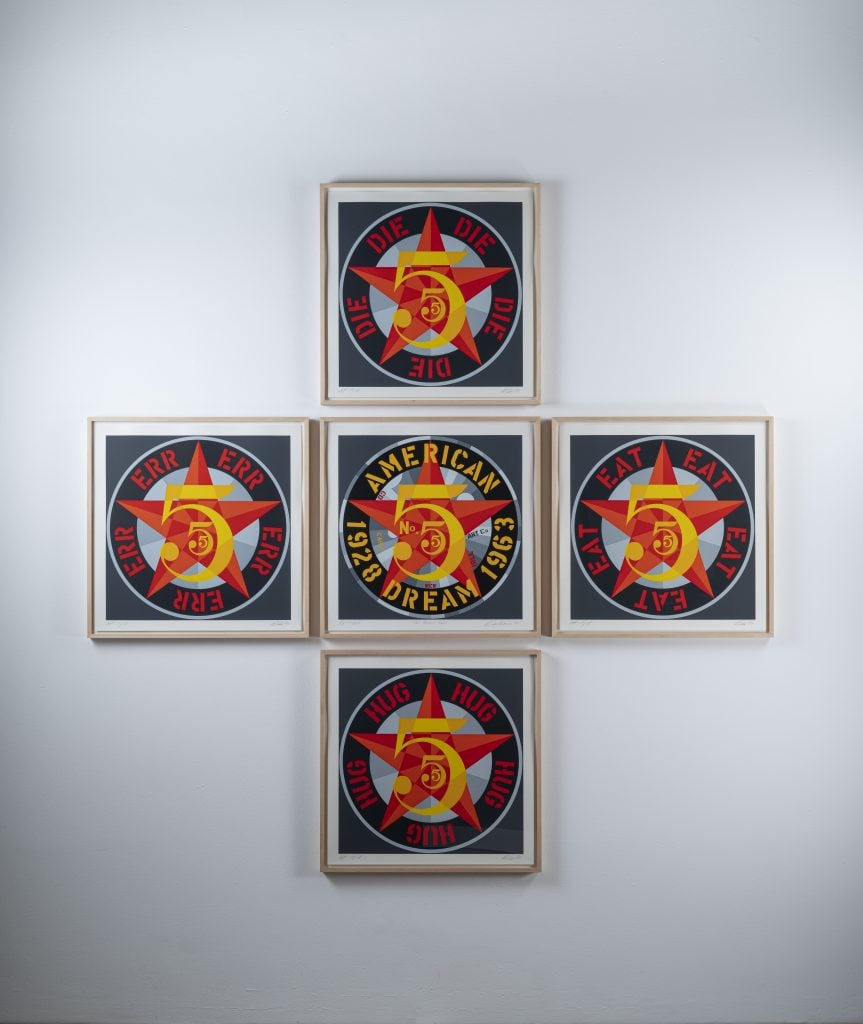
Robert Indiana, American Dream # 5 (The Golden Five) (1980). Installation view at Yorkshire Sculpture Park, 2022. Photo: © Jonty Wilde, courtesy of Yorkshire Sculpture Park. Artwork: © 2022 Morgan Art Foundation Ltd./ Artists Rights Society (ARS), New York/DACS, London
Highlights of the indoor portion of the exhibition include some of Indiana’s earliest relief and collage forms, as well as a selection of his totemic “columns” and “herms” incorporating found objects and salvaged materials from derelict warehouses near his studio in Manhattan.
Prints including The Melville Triptych reference Coenties Slip, the famous street where Indiana lived from 1956 alongside a community of notable artists, including Ellsworth Kelly, Agnes Martin, Robert Rauschenberg, and Cy Twombly. The exhibition is a delight of poetic, artistic, and literary references that fold in on themselves. These include Indiana’s column Call me Indiana, which references the first line of Moby Dick but also Indiana’s own pivot from his birth name in 1958.
Elsewhere, there are multiple homages to American poets and artists, notably Marsden Hartley—another successful gay painter who coded sexuality within his work—and Charles Demuth, who made his own painterly references to the object of his affection, American poet William Carlos Williams.
The exhibition also shows how engaging with significant social and political events has been a consistent theme throughout Indiana’s six decades of art-making. Work made during the Civil Rights movement include some of his “Confederacy” series of paintings, made in response to racist atrocities, while Love Rising (The Black and White Love) (1968) was made in the aftermath of the assassination of Dr. Martin Luther King, Jr.
As a gay artist working through the AIDS crisis in the 1980s, themes of love and acceptance abound, as do themes of unity. His 1985 column Ash, made after he moved to Vinalhaven, the island of the coast of Maine where he spent the later years of his life, is part memorial, part expression of belief in the afterlife, referencing the gay community’s response to the AIDS crisis.
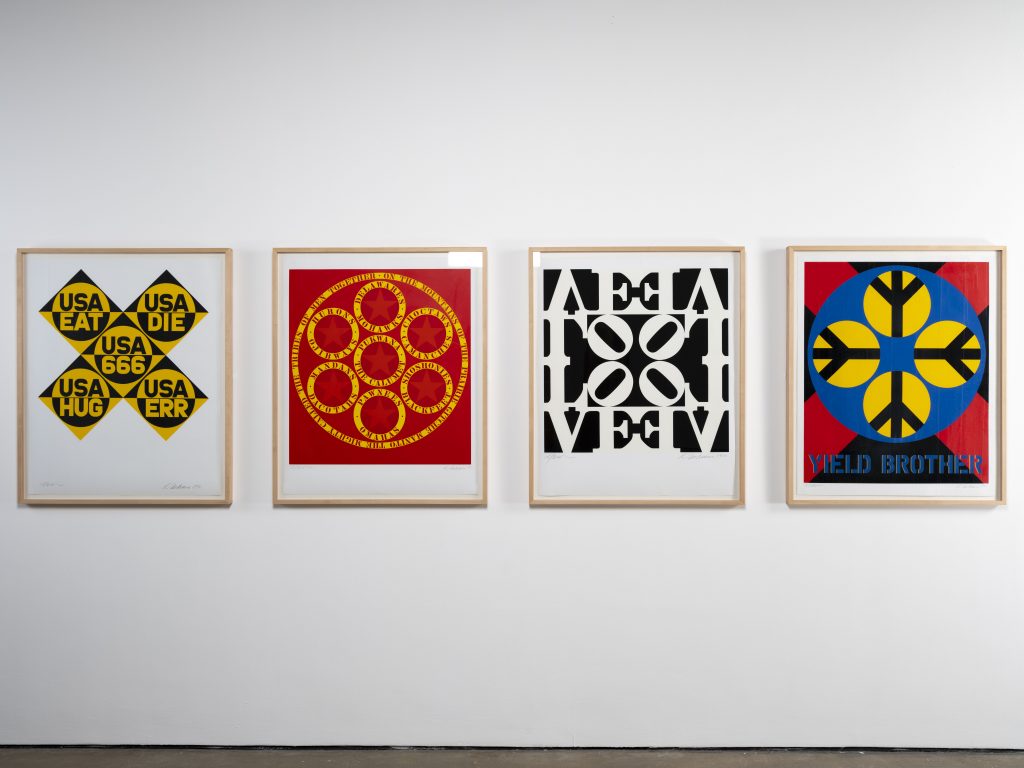
Robert Indiana, USA 666 (1964-66); The Calumet (1961); Black and White LOVE (1969); Yield Brother (1963). Installation view at Yorkshire Sculpture Park, 2022. Photo: © Jonty Wilde, courtesy of Yorkshire Sculpture Park. Artwork: © 2022 Morgan Art Foundation Ltd./ Artists Rights Society (ARS), New York/DACS, London
In various works and in many different permutations, a quartet of words, EAT DIE HUG ERR, recurs. In flashy electric versions seen in the YSP show, the cryptic phrase seems to nod to an optimism and belief in America, in line with the buoyant message of LOVE.
But elsewhere, scratchier versions of these same words, stenciled in prints of columns, carry a darker tone. Their troubled quality now suggests not the flashy veneer of American advertising vernacular, but the failure of reality to meet that optimism.
These works fill you with unease. They open up Indiana as an artist whose practice had far more breadth and depth to it than is betrayed by the happy messaging that made him famous.
“Robert Indiana: Sculpture 1958-2018” is on view March 12, 2022, through January 8, 2023 at Yorkshire Sculpture Park. See more images from the major exhibition below.
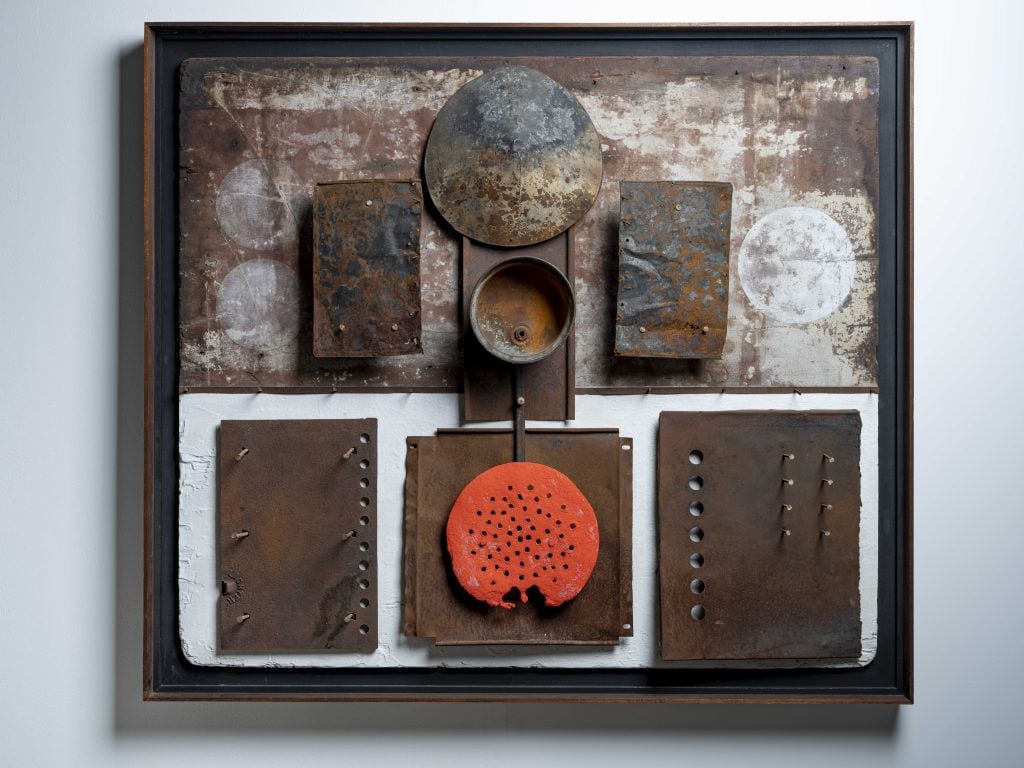
Robert Indiana, Wall of China (1960-61). Installation view at Yorkshire Sculpture Park, 2022. Photo: © Jonty Wilde, courtesy of Yorkshire Sculpture Park. Artwork: © 2022 Morgan Art Foundation Ltd./ Artists Rights Society (ARS), New York/DACS, London
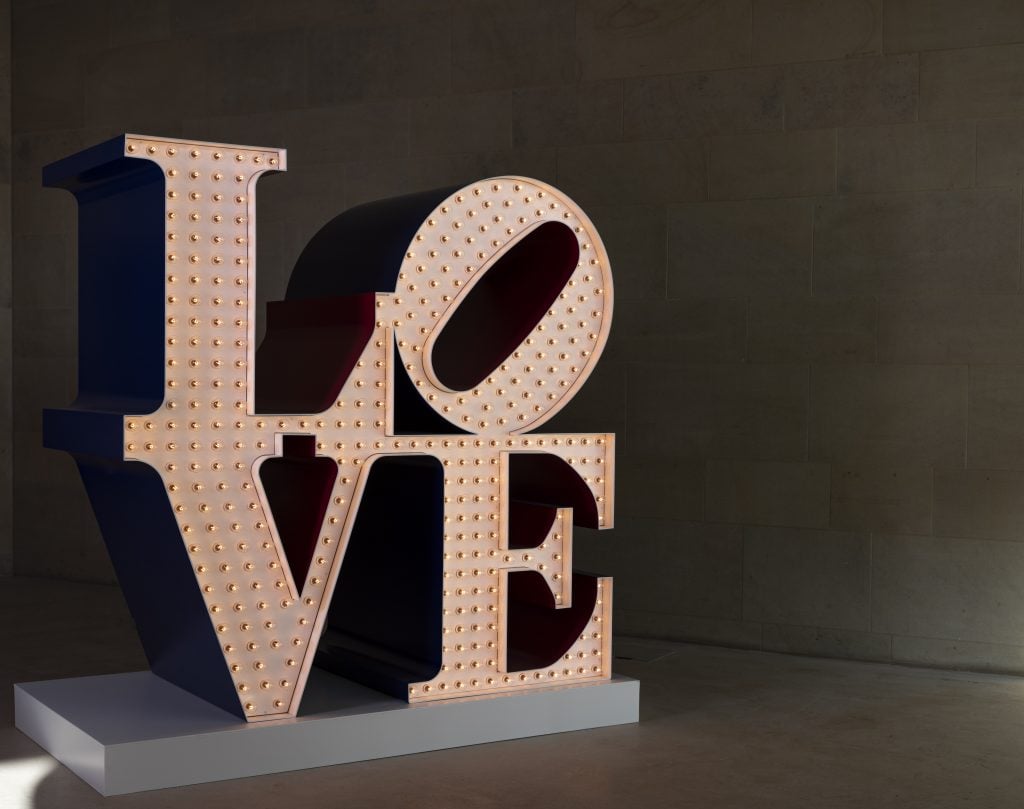
Robert Indiana, The Electric LOVE (1966-2000). Installation view at Yorkshire Sculpture Park, 2022. Photo: © Jonty Wilde, courtesy of Yorkshire Sculpture Park. Artwork: © 2022 Morgan Art Foundation Ltd./ Artists Rights Society (ARS), New York/DACS, London
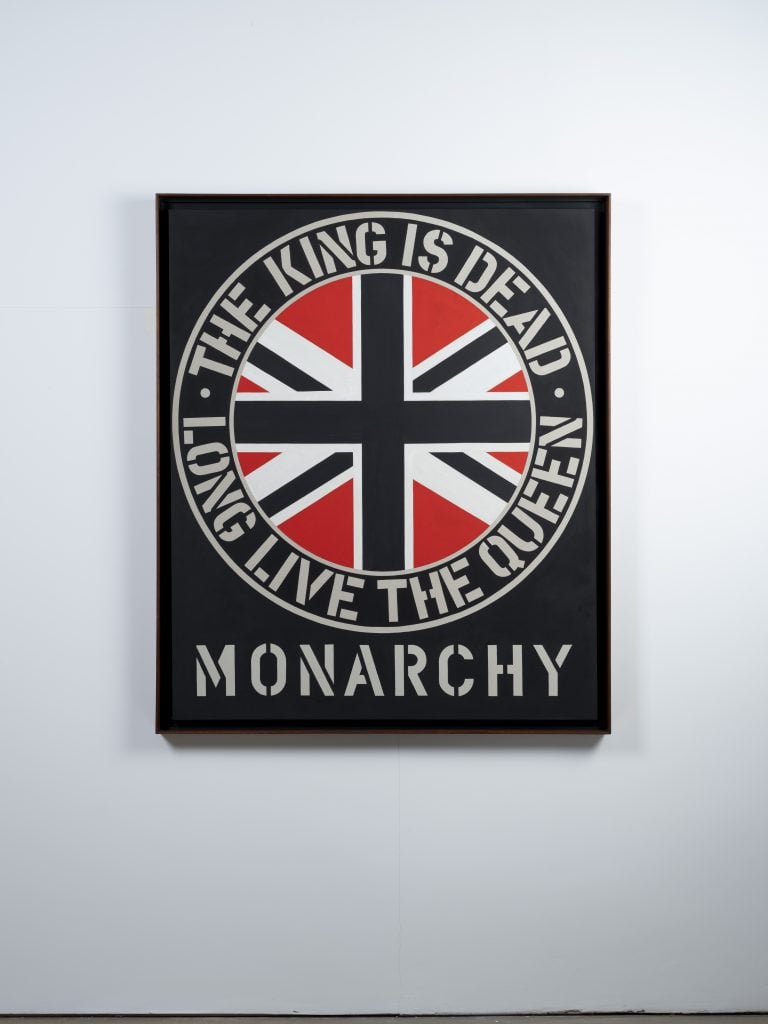
Robert Indiana, Monarchy (1969). Installation view at Yorkshire Sculpture Park, 2022. Photo: © Jonty Wilde, courtesy of Yorkshire Sculpture Park. Artwork: © 2022 Morgan Art Foundation Ltd./ Artists Rights Society (ARS), New York/DACS, London
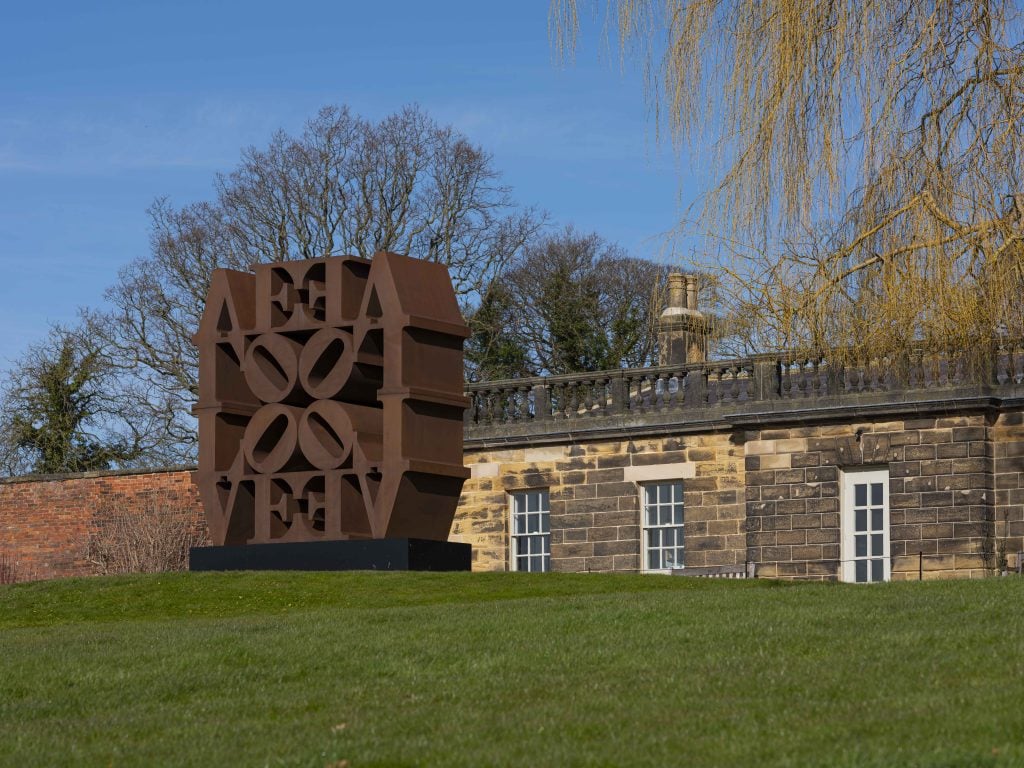
Robert Indiana, LOVE WALL (1966-2006). Installation view at Yorkshire Sculpture Park, 2022. Photo: © Jonty Wilde, courtesy of Yorkshire Sculpture Park. Artwork: © 2022 Morgan Art Foundation Ltd./ Artists Rights Society (ARS), New York/DACS, London
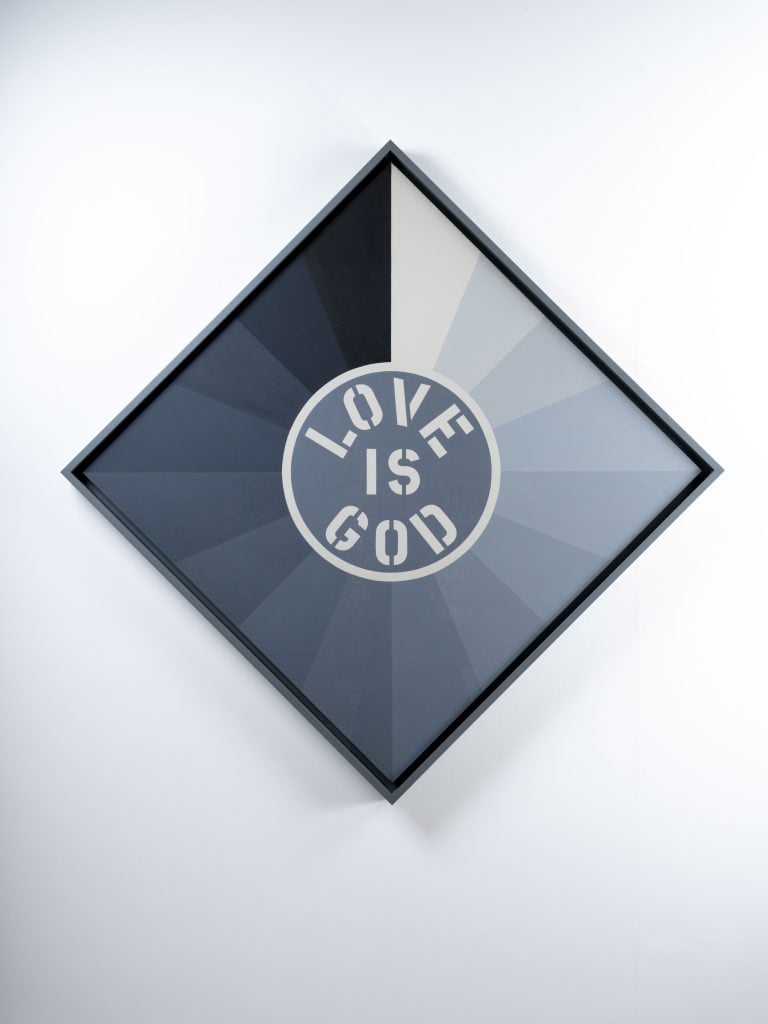
Robert Indiana, Love Is God (1964). Installation view at Yorkshire Sculpture Park, 2022. Photo: © Jonty Wilde, courtesy of Yorkshire Sculpture Park. Artwork: © 2022 Morgan Art Foundation Ltd./ Artists Rights Society (ARS), New York/DACS, London
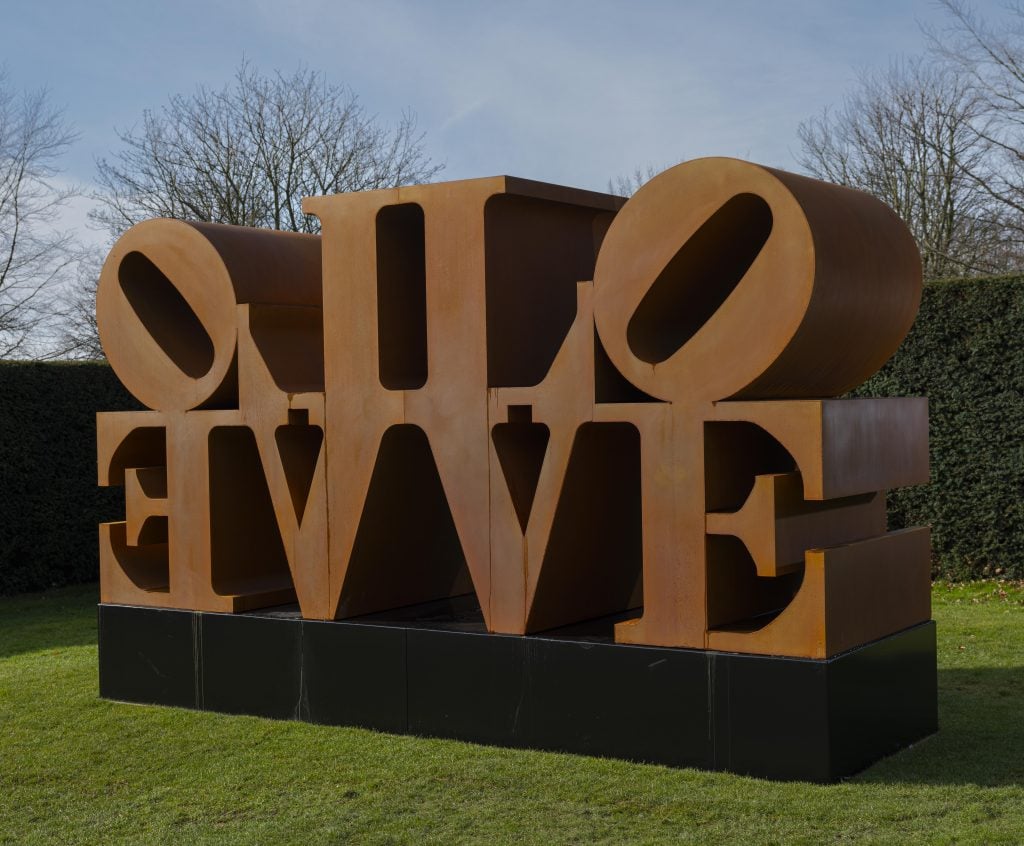
Robert Indiana, Imperial LOVE (1966-2006). Installation view at Yorkshire Sculpture Park, 2022. Photo: © Jonty Wilde, courtesy of Yorkshire Sculpture Park. Artwork: © 2022 Morgan Art Foundation Ltd./ Artists Rights Society (ARS), New York/DACS, London
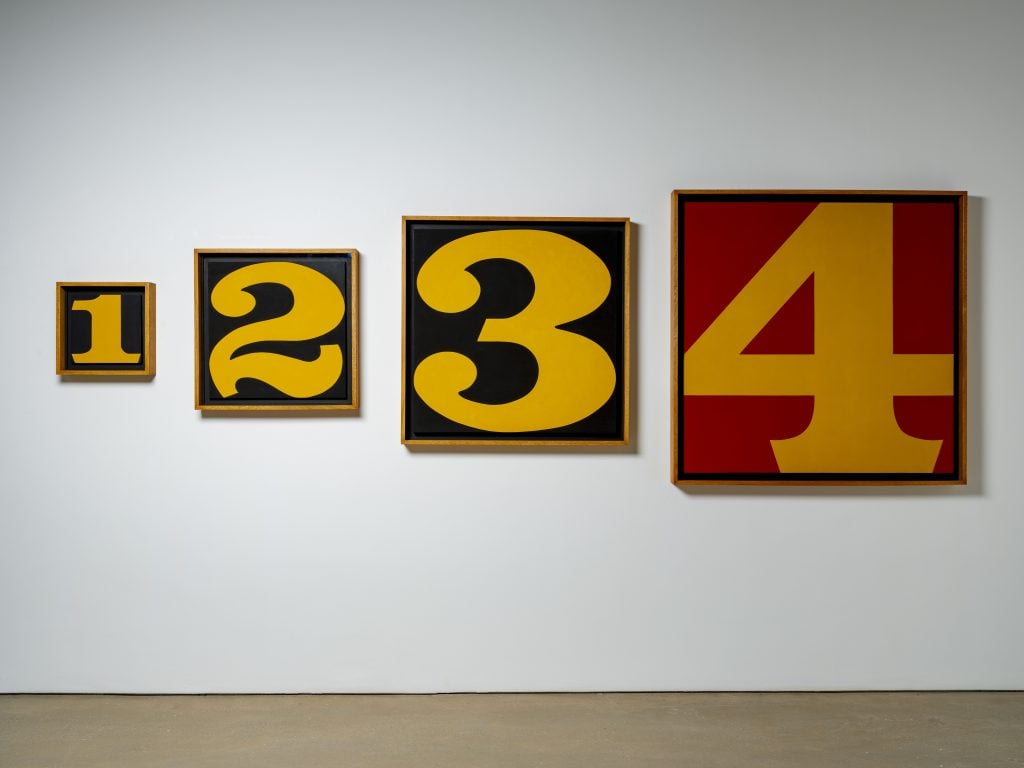
Robert Indiana, Exploding Numbers (1964-66). Installation view at Yorkshire Sculpture Park, 2022. Photo: © Jonty Wilde, courtesy of Yorkshire Sculpture Park. Artwork: © 2022 Morgan Art Foundation Ltd./ Artists Rights Society (ARS), New York/DACS, London
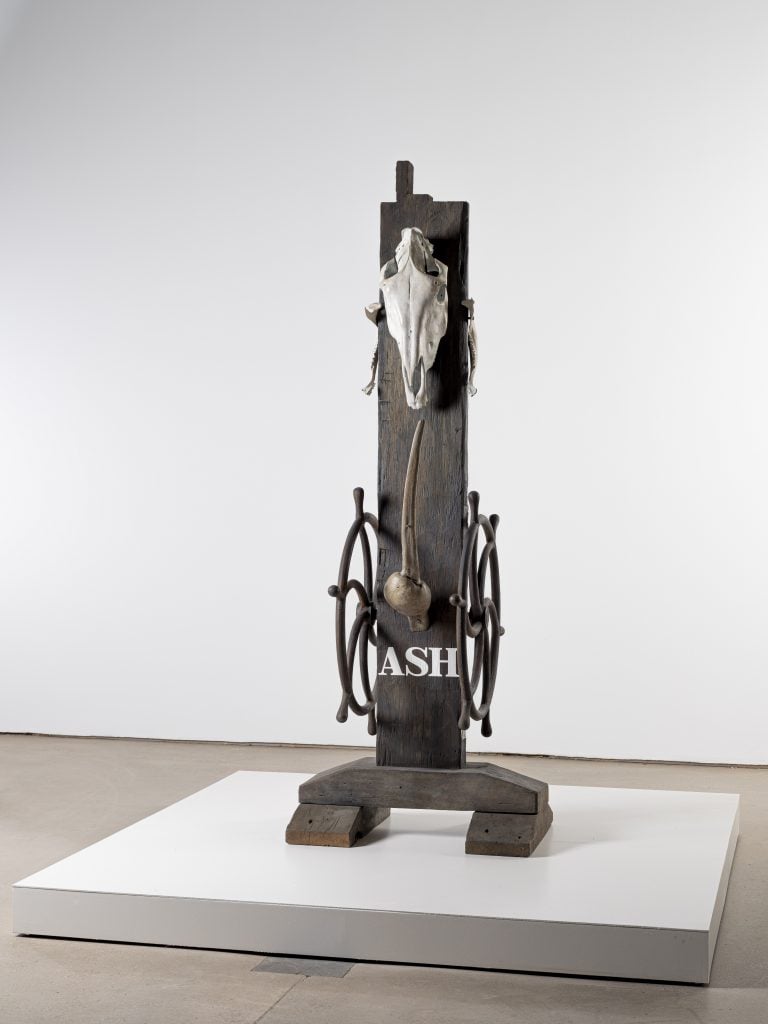
Robert Indiana, Ash (1985, cast 2017). Installation view at Yorkshire Sculpture Park, 2022. Photo: © Jonty Wilde, courtesy of Yorkshire Sculpture Park. Artwork: © 2022 Morgan Art Foundation Ltd./ Artists Rights Society (ARS), New York/DACS, London
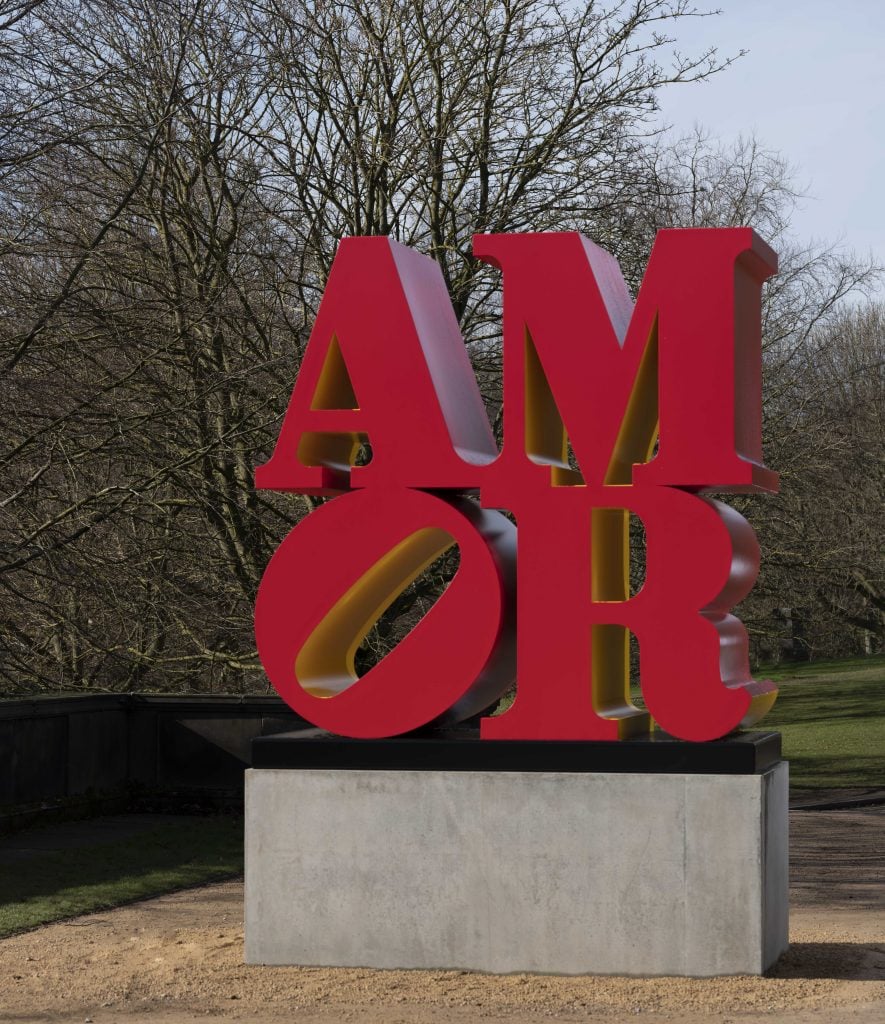
Robert Indiana, AMOR (Red Yellow) (1998-2006). Installation view at Yorkshire Sculpture Park, 2022. Photo: © Jonty Wilde, courtesy of Yorkshire Sculpture Park. Artwork: © 2022 Morgan Art Foundation Ltd./ Artists Rights Society (ARS), New York/DACS, London